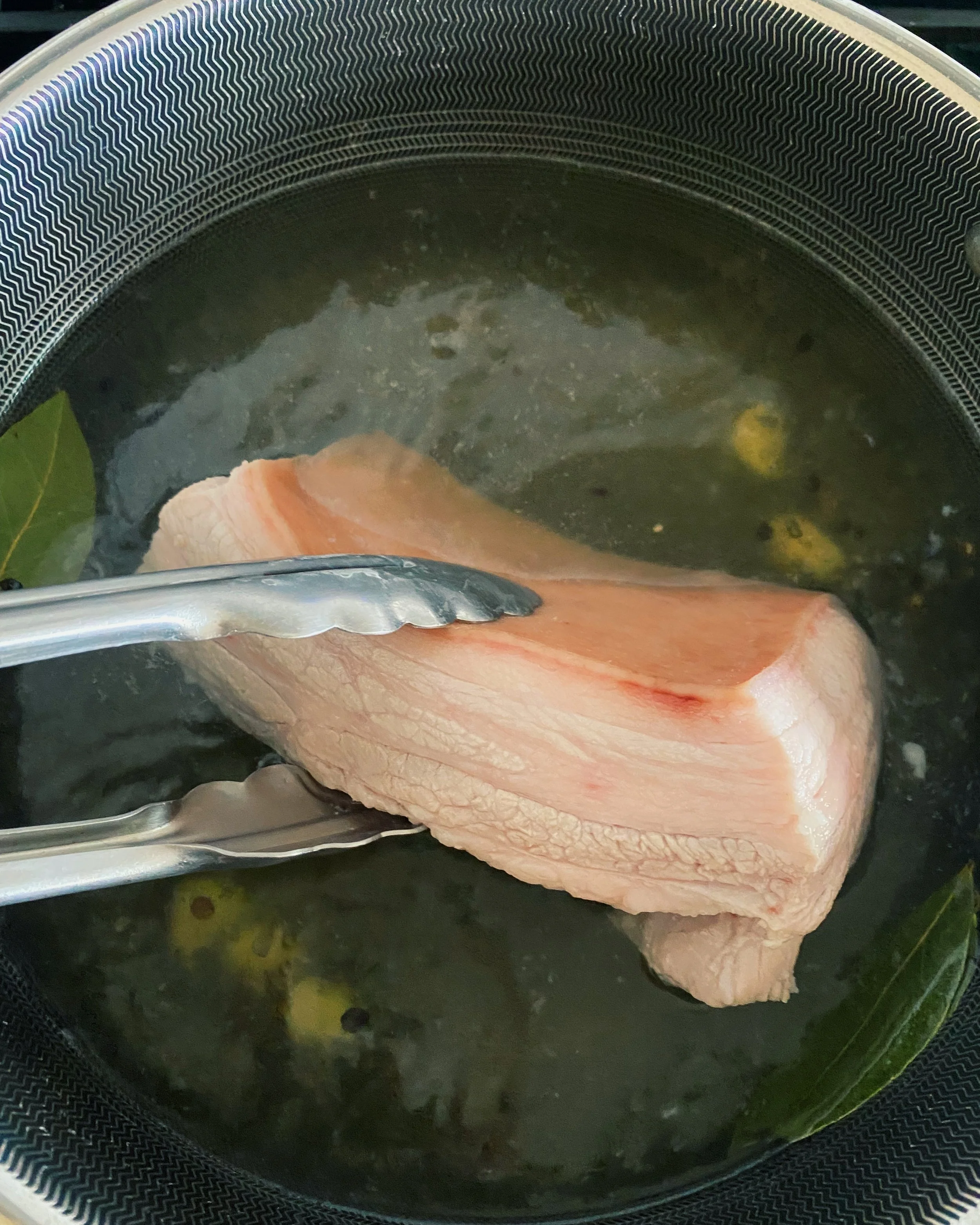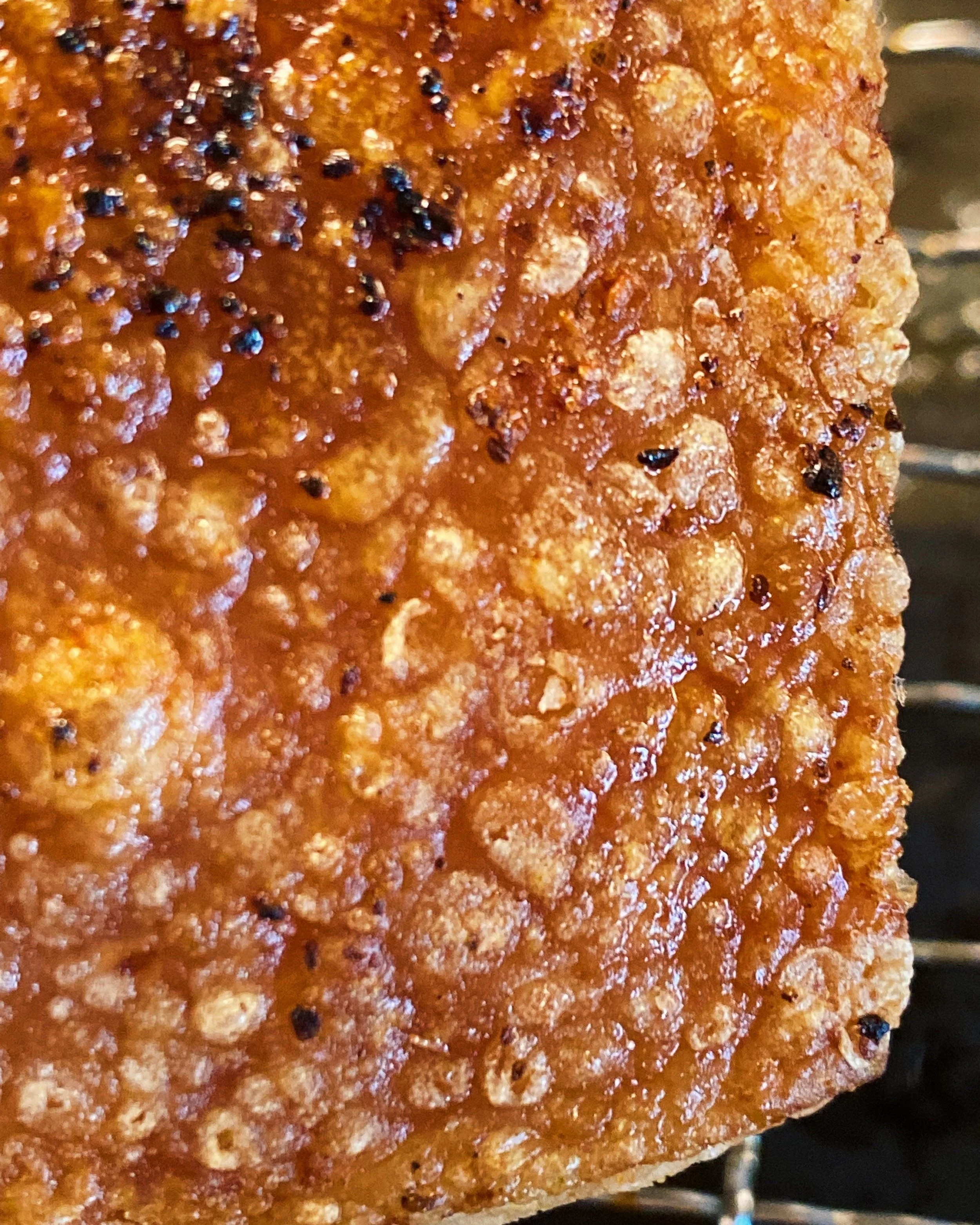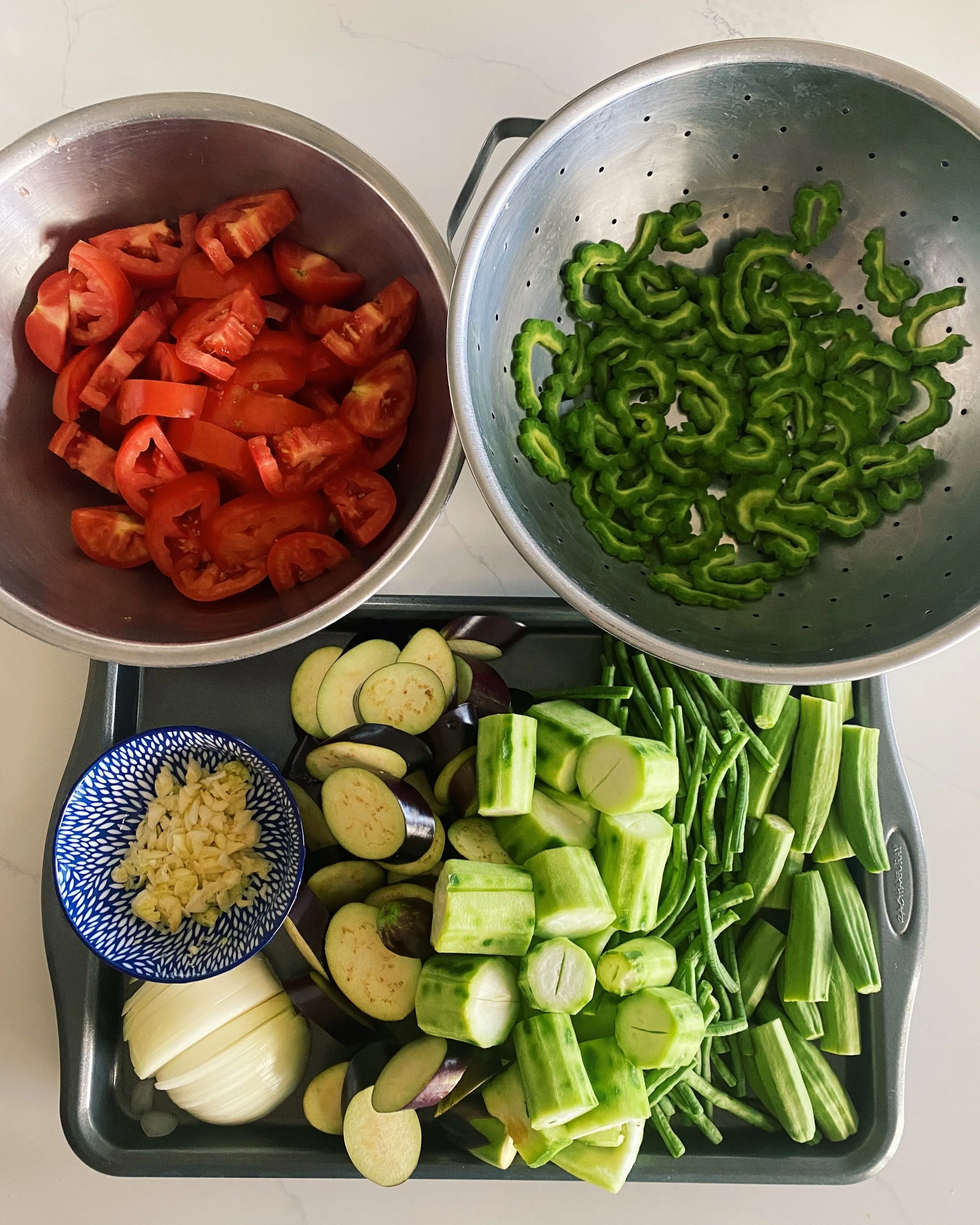Mama’s Ilocano Pinakbet with Bagnet
Pinakbet with Bagnet
Pinakbet originated from the Northern Provinces of the Philippines, specifically, Ilocos. It’s a mixed veggie stew that pays homage to the Ilocano farmers and help to support their harvest. My mom says it’s a heartfelt dish that Ilocanos can survive on, due to not having enough money since farming is their main source to provide for their family. This dish lets them use whatever vegetables are available. Pinakbet comes from the Ilocano term, “pinakebbet”, which means shrunk or shriveled. A stew cooked with all the seasonal vegetables together at once.
If you know my mom, you know that this is her signature dish that everyone in the family would ask her to cook for any occasion. This dish is the first Filipino dish that she taught me how to cook, side by side. You already know Filipino mom’s don’t usually do that. I always think she’s slowly passing me the torch to keep our culture alive, and help pass it along to the next generation. No matter how many miles away I am from her, I know when I cook this dish, I’ll forever feel like she’s right there with me when I’m homesick.
♥️ Bea Lugtu
Bea is a Filipino American artist, storyteller and illustrator. Click on her name above and follow her on Instagram.
INGREDIENTS
BAGNET*
1lb Boneless Pork Belly*
3 Bay Leaves
1 tbsp Peppercorns
2 tbsp Kosher Salt
5 cloves Garlic, peeled and left whole
2 tbsp Garlic Salt
Neutral Oil, for deep frying
PINAKBET
½ medium Yellow Onion, thinly sliced
8 cloves Garlic, thinly sliced
1 Bitter Melon, sliced in half, seeded, and sliced into 1/2 inch pieces* (optional)
4 Philippine Eggplant, top stem trimmed off, sliced into 1 inch pieces*
1 bunch Long Beans, ends trimmed, cut evenly into 2 inch pieces*
3 Loofah Squash, peeled, cut into fourths, each piece sliced halfway to create a slight opening*
20 pieces Okra, left whole with ends trimmed
7 small Tomatoes, sliced in half, then quartered
1/2 cup Bagoong Monamon, or to taste*
1 tbsp Kosher Salt, for bitter melon
2 tbsp Neutral Oil
NOTE: This recipe serves 5-7.
*BAGNET - This is a boiled and deep fried pork belly. It is the Ilocano version of Lechon Kawali. It is known for its chicharron like characteristics and terrific flavor.
*PORK BELLY - Choose pork belly with a 50/50 fat and meat ratio. In this recipe, it will deep fried but it can also be oven broiled (450ºF) or an air fryer could also be used (400ºF).
*BITTER MELON - Ampalaya in Tagalog, this vegetable is a bitter gourd and is optional as not everyone likes the bitterness of this vegetable. If using, to lessen the bitterness, liberally salt the bitter melon an hour before cooking then rinse and dry before cooking. This will not totally remove the bitterness but it will tone it down.
*PHILIPPINE EGGPLANT - If you cannot find this variety, any thin and long eggplant variety of Asian eggplant will be a good substitute like the Chinese or Japanese varieties.
*LONG BEANS - This is a legume like green beans with a long and thin pod. You can find this in your local Asian market and is usually tied together or packaged in a bundle.
*LOOFAH SQUASH - Patola in Tagalog, this vegetable is also called a Sponge Gourd. This can be found in your local Asian market. In a pinch chayote may be a potential substitute or it can also be omitted.
*BAGOONG MONAMON - This type of bagoong is made of fermented anchovies instead of the more common fermented shrimp. Bea prefers Finest Taste Pangasinan’s Special Bagoong “Tirong Monamon”, it tastes more fresh with halved fermented anchovies in the jar. But you can also use other bagoong brands to your liking. The bagoong should be a more liquid anchovies bagoong for this dish, not the alamang fermented shrimp paste to get the Ilocano taste profile of this dish. You can adjust the amount to your taste. Start with a few tablespoons and adjust to the recipe amount as needed.
METHOD
BAGNET
STEP 1
SIMMERING THE PORK BELLY
In a stock pot or dutch oven, fill with water half way and bring to a boil. Add in aromatics: bay leaves, peppercorn, kosher salt, garlic cloves. Once water is at a rolling boil, slowly lower the pork belly into the water. Lower to a simmer and cook for about 40 minutes, until cooked and tender.
NOTE: When filling stock pot with water, make sure there is enough water to cover the pork belly.
STEP 2
LET PORK BELLY COOL AND SEASON
Once done cooking, take the pork belly out of the simmering liquid and place on a sheet pan with a rack to dry, pat any excess moisture off with a paper towel, and let it rest until it is room temperature. Once cooled, cut pork belly into thirds and rub garlic salt around top skin and edges.
STEP 3
FINISHING THE PORK BELLY
Fill deep wok half way with neutral oil and heat up the oil at medium high. Once oil is hot, reduce heat to medium and slowly place pork belly into hot oil gently frying each side until golden brown, and skin is bubbly crispy. Fry pork belly one at a time and be very careful if the hot oil as it tends to pop a bit. Once done frying, drain excess oil on paper towels and let it cool for 10 minutes. When ready to serve, slice the pork belly into pieces.
NOTE: Other options to finishing the pork belly if you do not want to deep fry —-
1. Broil at 450ºF in oven on a rack, skin up, with a pan underneath for drippings for around 10 -15 mins or until golden brown and you can see the skin is bubbling and crispy. The timing may vary depending on your oven.
2. Air Fry 400ºF for 10 mins, or until golden brown and you can see the skin crispy and bubbling. The timing may vary depending on your air fryer.
PINAKBET
STEP 4
PREPARE THE BITTER MELON
In a small mixing bowl, place the sliced bitter melon and add in the kosher salt. Gently massage salt into the bitter melon and let it sit at room temperature for 20 minutes. After 20 minutes, rinse thoroughly until there’s no more salt left. This will help extract some of the bitter taste from the bitter melon. You’ll have a more subtle and less pungent bitterness.
STEP 6
COOKING THE PINAKBET
In a large Dutch oven, heat oil over medium high heat. Add onion and cook until fragrant, then add in the tomatoes. Close lid and let it cook for 5 minutes, stirring occasionally until tomatoes are tender. Once the tomatoes have softened, add in the sliced garlic and mix together well. Reduce the heat to medium, then add the bagoong and 1/2 cup of water, taste to see if more bagoong is needed. Make sure to slowly add bagoong so it’s not too salty. Next, add the eggplant and angled loofa, close the lid and let it simmer on medium for 5 minutes. Stir the vegetables and add the okra and long green beans. Close the lid again and let it simmer for 5 minutes or until okra is slightly tender. Finally, add the bitter melon and stir the vegetables one last time. Let it simmer without the lid for another 5 minutes until the vegetables are cooked but still vibrant.




































